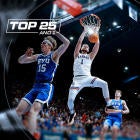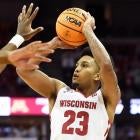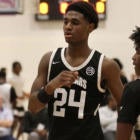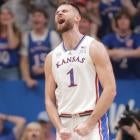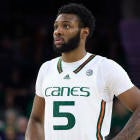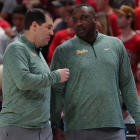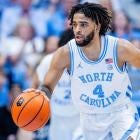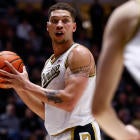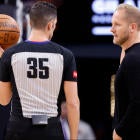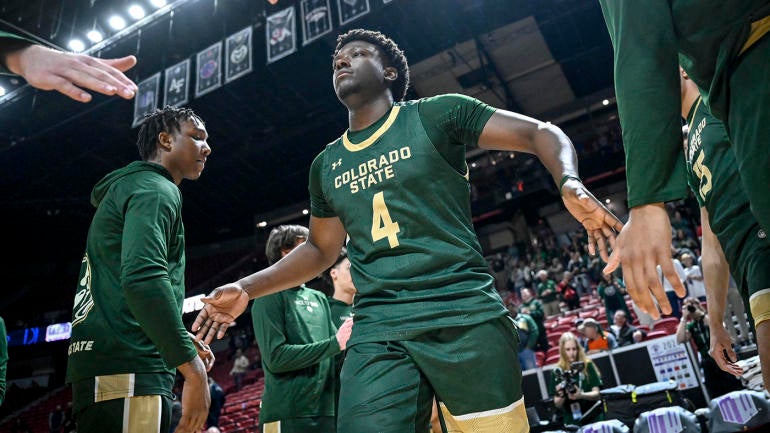
Realignment and expansion have been all the rage in college athletics over the last few years, but after nearly three decades the butterfly effect of the Western Athletic Conference -- yes the WAC! -- expanding in 1990s still wreaks havoc on March Madness brackets everywhere.
How? Well, the WAC's growth to 16 teams in 1996 disgruntled plenty of member schools, and by 1999, the Mountain West was born. In 2001, the men's NCAA Tournament expanded from 64 to 65 to accommodate a new automatic qualifier. A decade later, 65 expanded to 68, a move that "preserved the character and integrity of what's been created," then-Big East commissioner John Marinatto said after coaches had pushed for 96.
Ever since that most recent expansion, these First Four teams have proved that while the "first round" begins on Thursday, Tuesday and Wednesday bring to goods, too. In the 12 tournaments since its debut, the First Four has produced 12 teams that make at least the Round of 32. In 2023, multiple First Four teams did so.
It's not March without brackets. Get your bracket pools ready now and join our men's and women's challenges for the chance to win big-time prizes!
| Year | Team | Result |
|---|---|---|
| 2011 | (11) VCU | Final Four |
| 2012 | (12) South Florida | Second round |
| 2013 | (13) La Salle | Sweet 16 |
| 2014 | (11) Tennessee | Sweet 16 |
| 2015 | (11) Dayton | Second round |
| 2016 | (11) Wichita St | Second round |
| 2017 | (11) USC | Second round |
| 2018 | (11) Syracuse | Sweet 16 |
| 2021 | (11) UCLA | Final Four |
| 2022 | (11) Notre Dame | Second round |
| 2023 | (16) Fairleigh Dickinson | Second round |
| 2023 | (11) Pittsburgh | Second round |
Only once since it was instituted has the First Four failed to produce a team in the Round of 32. Deep runs aren't uncommon, either; UCLA (2021) and VCU (2011) shredded brackets everywhere.
We'll never forget Fairleigh Dickinson just like we'll never forget UMBC, but for the purposes of assessing which teams could join the list above, we're focusing on the First Four No. 10 seeds: Virginia, Colorado State, Boise State and Colorado. The Cavaliers and Rams meet Tuesday, the Broncos and Buffaloes Wednesday. They all have significant flaws -- that's why they were on the bubble -- but they were all included for a reason, too. Plus, history suggest at least one of them could impact your bracket in the Round of 64 ... and maybe beyond. Here's how likely each candidate is to do so:
1. Colorado
There are a lot of things to like about these Buffaloes. They're playing well of late: After dropping four of five in late January and early February, Tad Boyle's squad reeled off eight straight wins and made the Pac-12 Tournament final. Over that span, the Buffaloes have been the 15th-best team in the nation according to barttorvik.com.
Numbers like that are great, but numbers don't win games. Players do, and Colorado has plenty. Pac-12 first teamer KJ Simpson makes the Buffaloes go. The junior guard shoots the lights out (45% from 3) and fills the box score, averaging 19.6 points, 5.7 rebounds and 4.9 assists.
Tristan da Silva and Eddie Lampkin, meanwhile, make up a frontcourt of contrasting styles. Da Silva made 55 3-pointers this season (38%) as is a versatile offensive talent. Lampkin, a 6-foot-11, 265-pound (generously listed) bulldozer has never attempted a 3-pointer in his career. But he's a strong presence inside who rebounds well, draws a ton of fouls and was a key part of multiple TCU Tournament teams. Simpson, da Silva and Lampkin make an experienced trio, and experience is vital in March.
Then there's freshman Cody Williams, a potential top-10 pick in this summer's NBA Draft whom our Cameron Salerno wrote about last month. Injuries have contributed to an up-and-down year, but the talent is undeniable, and talent is very helpful, especially in single-elimination scenarios.
Finally, I like the First Four matchup against Boise State. The Buffaloes are terrific in transition, scoring 1.16 points per transition possession. That's 29th in all of Division I. Boise State, meanwhile, allows 1.16 points per transition possession, 349th(!) in Division I. Expect Boyle to start the engines and get his multi-talented team running, as seen below.
2. Colorado State
Isaiah Stevens is already the stuff of legends in Fort Collins as the program's all-time leading scorer and assister, but he's never won an NCAA Tournament game. Now's the time to change that, and he has plenty of help in Colorado transfer Nique Clifford and former Division II player of the year Joel Scott. Clifford is making 38% of his 3-pointers, second on the team to Stevens, and Scott is a tireless interior scorer shooting nearly 63% on 2-pointers.
But it all comes back to Stevens. Great, experienced guard play often does well in March, and Stevens is both. He's the only player this season averaging 16 points and six assists while shooting at least 44% from 3. In an early-season blowout of Creighton, he had 20 points and seven assists. Six days later, he dropped 20 points and 11 assists to beat Colorado. He's up there with the premier guards in the country, and he's a great big-game player at that.
The Rams surged as high as No. 13 in the AP Top 25 during a strong start but faded somewhat afterward. To get back there, the Rams have to hit shots: They were at 39% from deep through 13 games and are at 31% since. The inside-outside Stevens/Clifford-Scott combination can carry the Rams offensively, though, and not many teams can match that.
3. Boise State
Boise State is dancing for a third straight season, a first in program history. But it wasn't easy. After a blowout loss at Utah State on Feb. 10, the Broncos were 16-8. Then Tyson Degenhart came alive, averaging 19.6 points as the Broncos won six of their final seven regular-season games before falling to New Mexico in the conference tournament.
Some numbers like the Broncos a lot. In a six-bid Mountain West, the Broncos were lights-out in key categories.
| Metric | vs. MWC opponents | Rank |
|---|---|---|
Offensive efficiency | 114.6 | 1st |
Offensive rebounding percentage | 34.8% | 1st |
Defensive rebounding percentage | 78.7% | 1st |
Free throw percentage | 75.5% | 1st |
Defensive efficiency | 102.7 | 2nd |
3-point percentage | 35.2% | 3rd |
Opp. 3-point percentage | 31.2 | 3rd |
So why are the Broncos only third on this list? First, as outlined above, it's a tough matchup. Second, the defense comes and goes. In conference wins, they allowed 64.8 points per game. In conference losses, that rose to 76.8. Their average conference win came by 14.9 points, their average loss by 10.4.
The argument for the Broncos is they're versatile and experienced with no clear weaknesses. The argument against them is they've been hard to trust, and other than defensive rebounding, they're not elite at anything. They're fittingly 9-9 in Quad 1 and Quad 2 games. They usually beat who they should and split the toss-ups. In March, I want something I can trust, and if I can't get that, I want a team with an awesome top gear. Boise State just doesn't quite fit either.
4. Virginia
Tony Bennett's teams have been quite steady over the past decade ... until this year. Nine of the Cavaliers' 10 losses this season were by double digits. After back-to-back losses to NC State and Wake Forest (by a combined 35 points), the Cavaliers reeled off eight straight wins seemingly out of nowhere, only to drop five of their final nine games.
Virginia leans on absolutely terrific defense. Reece Beekman won ACC Defensive Player of the Year for the second straight season, and Ryan Dunn is one of the nation's premier wing defenders. The offense, though, is anemic. The Cavaliers are 194th in offensive efficiency, per kenpom.com, the worst ranking ever for a Bennett-coached team. The Cavaliers rank 328th in 2-point field goal percentage and 355th in free-throw shooting. The Cavaliers are a solid 3-point shooting team (36%), but that production comes almost exclusively from Isaac McKneely (46%) and Jake Groves (47%).
So how are the Cavaliers here? They're 9-0 in games decided by six points or fewer, thanks in large part to their defense, their terrific care of the basketball (fifth in turnover rate) ... and a lot of luck. And while you need luck in the NCAA Tournament, you can't depend on it.
The optimistic outlook is that Colorado State's biggest strength (Stevens) faces Virginia's biggest strength (perimeter defense). Beekman's track record of shutting down opposing guards is outstanding.
| Notable guards vs. UVa | Points | FG-FGA |
|---|---|---|
12 | 1-14 | |
Wade Taylor | 9 | 2-10 |
Walter Clayton | 12 | 3-11 |
2 | 0-8 |
But in order to make a run, the offense has to string something together, and that just hasn't happened this season.
Get every pick, every play, every upset and fill out your bracket with our help! Visit SportsLine now to see which teams will make and break your bracket, and see who will cut down the nets, all from the model that beat over 92% of CBS Sports brackets players three of the last five years.













